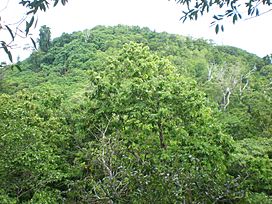Samoan tropical moist forests facts for kids
Quick facts for kids Samoan tropical moist forests |
|
|---|---|

Lowland rain forest on Savai'i
|
|

Map of the Samoan Islands
|
|
| Ecology | |
| Realm | Oceanian |
| Biome | tropical and subtropical moist broadleaf forests |
| Geography | |
| Area | 2,763 km2 (1,067 sq mi) |
| Countries | Samoa and American Samoa (U.S.) |
| Conservation | |
| Conservation status | Critical/endangered |
| Protected | 231 km² (8%) |
The Samoan tropical moist forests are special ecoregions found on the Samoan Islands in the Pacific Ocean. An ecoregion is a large area of land or water that contains a unique set of natural communities and species. These forests are known for being very wet and green, filled with many different kinds of plants and animals.
About 30% of all living things in Samoa are endemic. This means they are found only in Samoa and nowhere else in the world! Scientists are still discovering new species here. For example, two new types of butterflies were found in 2009, along with new freshwater fish. Samoa actually has more native ferns and butterflies than New Zealand, even though New Zealand is 85 times bigger!
Contents
Where are the Samoan Tropical Moist Forests?
The Samoan Islands are located in the middle of the Pacific Ocean. They were formed by volcanoes, which means they have a lot of mountains and hills. The total area of these islands is about 3,030 square kilometers.
The two biggest islands are Savai'i and Upolu. The islands are split into two main parts: Samoa, which is an independent country, and American Samoa, which is a territory of the United States.
What is the Climate Like?
The islands are just south of the equator, so they have a warm, humid tropical climate. It rains a lot here, with more than 2,000 millimeters of rain falling every year. This heavy rainfall helps the forests stay moist and green.
Plants of the Samoan Forests (Flora)
The Samoan forests have many different types of plant communities. The most common type is the lowland rain forest, which covers large areas. At higher elevations, you can find montane forests and even cloud forests, where the trees are often covered in mist.
There are also smaller areas with unique plants, like:
- Montane scrub
- Pandanus scrub
- Littoral (seashore) scrub
- Montane swamp forest
- Summit scrub
The Central Savai'i Rainforest
The Central Savai'i Rainforest is a huge area of forest on the island of Savai'i. It covers about 727 square kilometers, making it the largest continuous rainforest in all of Polynesia. This area is very special because it has more than 100 old volcanic craters and even some recent lava flows.
This rainforest stretches across the middle of Savai'i. It is home to most of Samoa's unique native species, many of which are in danger of disappearing forever.
Animals of the Samoan Forests (Fauna)
The Samoan tropical moist forests are home to many unique animals, especially birds.
Unique Birds of Samoa
Some of the special birds found here include:
- The rare tooth-billed pigeon (Didinculus strigirostris), which is known as manumea by local people. It is also Samoa's national bird.
- The maomao honeyeater (Gymnomyza samoensis).
- The Samoan white-eye (Zosterops samoensis).
- The Samoan moorhen (Gallinula pacifica).
The Samoan white-eye and Samoan moorhen are only found on Savai'i. The Samoan moorhen was last officially seen in 1873, but there might have been sightings in 1984 and near Mount Silisili in 2003.
Protecting the Samoan Forests (Conservation)
Protecting these special forests is very important. Most of the land in Samoa, about 81%, is owned by local communities under traditional rules. These lands are managed by matai, who are the chiefs or heads of families.
Because of this, conservation projects work closely with the matai. For example, there are lowland rainforest preserves in Falealupo village on Savai'i and Tafua village on the southeast coast. These partnerships help protect the forests for future generations.
Why is Conservation Important?
Many of the plants in these islands are used by local people for food, making things like fiber, and for traditional Samoan medicine. Protecting the forests means protecting these important resources and the knowledge of how to use them.
In 1994, Samoa agreed to an international treaty called the Convention on Biological Diversity. This treaty helps countries create plans to protect their biological diversity (all the different kinds of life) and use it in a way that doesn't harm the environment. By 2010, protected areas in Samoa covered 5% of the country's land.
Protected Areas in Samoa
Several areas in Samoa have been set aside as national parks or protected zones to keep their natural beauty safe. These include:
- Cornwall National Park (24.94 km²)
- Lata National Park (49.92 km²)
- Mauga o Salafai National Park (59.73 km²) - all on Savai'i.
- Lake Lanotoo National Park (4.7 km²)
- O Le Pupu Pu'e National Park (50.19 km²) - both on Upolu.
- The National Park of American Samoa - located on Tutuila, Ofu, and Ta‘ū.
Images for kids
-
Hypolimnas bolina butterfly.





